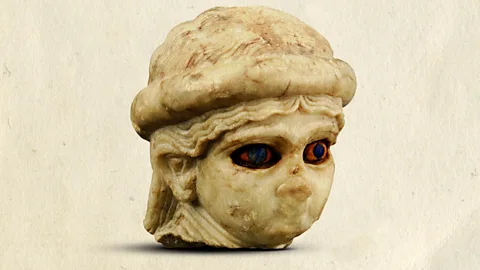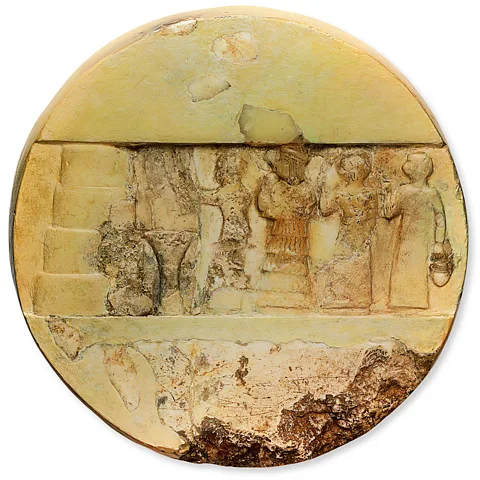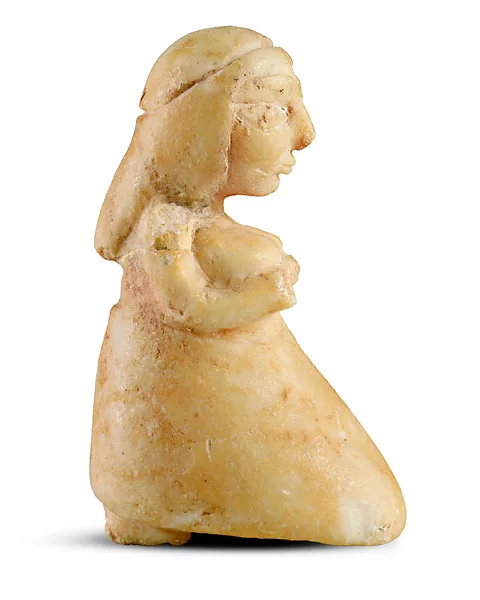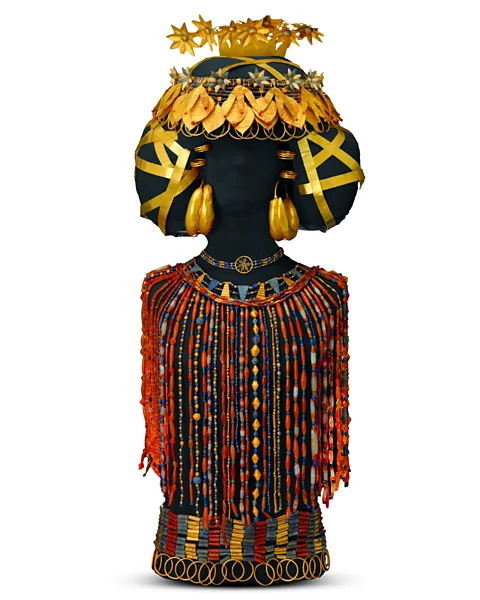Enheduanna: The world's first named author
 The Penn Museum
The Penn MuseumA little-known Mesopotamian poet and priestess, Enheduanna, is the subject of a new exhibition in New York. Diane Cole explores her influence – and looks at how she helped create a common system of beliefs throughout the ancient empire.
She was the first author to be named in all recorded history: the Mesopotamian poet, princess, and priestess Enheduanna. Surprised? "When people ask who is the first author, they never guess anyone in Mesopotamia, and it's never a woman," says Sidney Babcock, curator of the recently opened exhibition at New York City's Morgan Library, She Who Wrote: Enheduanna and Women of Mesopotamia, ca 3400-2000 BC. Usually, he says, they suggest a figure from ancient Greece; if they do mention a female author at all, it's Sappho, who lived a millennium later, and less of whose work survives than that of Enheduanna.
If you've never heard of her, you're not alone. Enheduanna was unknown to modernity altogether until 1927, when the archaeologist Sir Leonard Woolley excavated objects that bear her name. We now know that her name, in Sumerian, means "Ornament of Heaven", and as the high priestess of the moon deity Nanna-Suen, she composed 42 temple hymns and three stand-alone poems that, like the Epic of Gilgamesh (which is not credited to a named author), scholars consider an important part of Mesopotamia's literary legacy.
In conjunction with her status as a religious figure and priestess, Enheduanna wielded political power as the daughter of Sargon the Great – a figure credited by some historians as the founder of the world's first empire. In particular, she played an essential role helping bind together the northern Mesopotamian region of Akkad, where Sargon first rose to power, before he went on to capture the Sumerian city-states in the south. She did so by helping meld the beliefs and rituals associated with the Sumerian goddess Inanna with those of the Akkadian goddess Ishtar, and by emphasising those links in her literary and religious hymns and poems, thereby creating a common system of beliefs throughout the empire. Each of the hymns Enheduanna wrote for 42 temples in the southern half of Mesopotamia highlighted the unique character of the patron goddess to the worshippers in those cities; the hymns were copied by scribes in the temples for hundreds of years after her death.
 The Yale Babylonian Collection/ Photo by Klaus Wagensonner
The Yale Babylonian Collection/ Photo by Klaus WagensonnerEnheduanna's writings are on display throughout the show – not in the manuscripts we are used to viewing in exhibitions featuring, say, Jane Austen or Charlotte Bronte, but on clay tablets bearing the wedge-shaped imprints known as cuneiform. In this excerpt, from her poem The Exaltation of Inanna, she describes the creative process:
"I have given birth,
Oh exalted lady, (to this song) for you.
That which I recited to you at (mid)night
May the singer repeat it to you at noon!"
And she lays claim to her authorship at the conclusion of the Temple Hymns, stating:
"The compiler of the tablet (is) Enheduanna. My lord, that which has been created (here) no one has created before."
"The voice we hear in the hymns is that of a gifted poet," writes Jungian analyst and Enheduanna translator Betty De Shong Meador in her 2009 book Princess, Priestess, Poet. “She describes with candour the everyday lives, cares, and inherent nature of the deities and their temples. She populates the entire surrounding cosmos with active, engaging, uncontrollable divine beings.”
Those poems further could hint at Enheduanna's solid grasp of mathematics – perhaps not so surprising when you remember that historians trace maths' origins to Mesopotamia, right alongside the development of cuneiform and other early writing systems. Both writing and counting were probably developed by necessity in Mesopotamia's active agricultural and textile economy, where the systems became intertwined as farmers and merchants counted what was produced, and recorded what was being sold and traded.
 The Penn Museum
The Penn MuseumThe exhibition, Babcock hopes, will bring Enheduanna greater visibility. We see her portrayed in a calcite disc, dating to approximately 2300 BC, and excavated by Woolley in 1927. The carved scene depicts Enheduanna accompanied by three simply-dressed attendants carrying ritual objects, all marching solemnly in line outside a stepped, ziggurat-like temple. She is identifiable by her elaborate circular headdress and her tiered, flounced robe. Enheduanna's face is shown in profile, as she raises her eyes to Inanna, goddess of love and war. She maintained her position for 40 years, until her death.
Ancient feminism
Beyond Enheduanna, the 90-some objects on display in the exhibition (ranging from varied statuary and cuneiform tablets to wall plaques as well as a multitude of cylinder-shaped seals alongside the images and impressions left when they were rolled on a clay or stone tablet) highlight the many ways in which women increasingly participated in various aspects of Mesopotamian society. By showing women's greater visibility in the third millennium, "I wanted to set the stage for Enheduanna," says Babcock, adding that as a society, Mesopotamia was in that era less patriarchal than elsewhere. Indeed, he quips, in Mesopotamia at that time, "There would have been no Downton Abbey because in this era women could own property," and it could be inherited through the female line.
This period, starting in approximately 3400 BC, saw a vast growth in Mesopotamia's urban centres and a continuing expansion in producing and trading goods throughout the country and the region. Increased business orders meant a need for more workers – many of whom were women. Going beyond their traditional roles at home or taking on religious duties, these women took on roles in a wide variety of trades, including ceramics, weaving, baking, animal husbandry, brewing, and artisan work. One image on display captures a group of women at the loom, weaving, with one figure in full motion, her hair flying behind her. Another shows women at what looks like a pottery wheel; in others, women sit and dine with men, apparently as equals. They are also seen playing musical instruments, in groups or solo, as depicted in an exquisite shell inlay in which a woman holds a flute to her mouth, delicate ribbons wound around her curly hair.
 Les frères Chuzeville
Les frères ChuzevilleAnd this is just one example in what can be viewed as a fashion show highlighting the changing and often elaborate hair and clothing styles favoured by the women of Mesopotamia. Statuettes, some as small as Barbie dolls, sport thick hair braids wound around the head like a coil; crossed headbands hold long, flowing wavy hair in place; ankle-length robes with tiered rows of hanging loops give the appearance of bird feathers; one particularly notable robe has a geometrically intertwined pattern that echoes thatched leaves or reeds. Most of these female figures stand in place, in bare feet, with clasped hands and subdued smiles, as if in prayer.
Royal splendour
Then there is the show's visual centrepiece: the stunningly colourful funerary ensemble of Queen Puabi, who lived approximately 150 years before Enheduanna. As befitting a queen, Puabi's splendiferous headdress is made up of hammered leaves and ribbons of gold as well as circular beads composed of lapis lazuli and carnelian. On top of those ornaments further sits an intricate crown-like comb adorned with star-like flowers – all in gold, just like the series of hair coils and accompanying set of large moon-shaped earrings. Equally majestic are the colourful strands of beads of gold and semi-precious stones that reach from neck to waist, around which winds a belt fringed with gold ringlets. These were all also uncovered by excavations led by Woolley, and made as big a splash in the late 1920s as the discovery of Tutankhamun's tomb in Egypt had done in 1922.
 The Penn Museum
The Penn MuseumEven so, "We know very little about Queen Puabi," who lived around 2500 BC, says Babcock, explaining that we only know her name because it appears on a lapis lazuli cylinder seal found on her body. Babcock explains that cylinder seals – most no larger than a spool of thread – proliferated throughout Mesopotamian society, serving as both a personal ID and a way to authenticate a communication or the contents of, say, a jar. Most significant for those trying to reconstruct Mesopotamian life today, intricate designs and images were often carved onto the seals, their impressions yielding a wealth of detailed information about all strata of society.
In addition to mortal women, these cylinder seals show the changing nature of the two major female deities Inanna and Ishtar, whose different profiles Enheduanna helped merge into one interchangeable goddess. Before Sargon's conquest of Sumer, Inanna represented the divine feminine principle who was the nurturing mother and the queen of heaven overseeing and preserving the cycle of life. Her face was generally not shown but her presence symbolised by rings of bundled reeds.
But change was under way, and by 2400 BC, a vessel fragment shows a female deity visualised in human form. Wearing a horned crown with leafy, vegetable-like material protruding from her shoulders and holding a cluster of dates, she has the aspects of fertility and fecundity associated with Inanna, but the animal-like crown also suggests fierceness.
With the reign of Sargon and through Eneheduanna's hymns, an ever-more war-like female deity begins to be depicted: Ishtar, seen portrayed in the exhibition with weapons coming out of her shoulders and her foot atop a lion whose leash she wields. In her poems, Enheduanna similarly portrays Inanna/Ishtar as a powerful goddess of combat and conquest as well as of love and abundance. And, according to Babcock, cylinder seals in the exhibition actually illustrate scenes from her poem, Inanna and Ebih.
The text pits an embattled, enraged Inanna against her enemy, a mountain range that refuses to bow down or cede to her. We see the goddess, armed with knife and axes, cause the mountain's stones to cascade downward, and kill the mountain's male god. "She sharpened both edges of her dagger. She took Ebih's neck as if tearing up grass. She presented the blade into its heart," and "yelled like thunder" so that "the stones making up Ebih crashed down its back." She then celebrates her conquest by triumphantly placing her foot atop the fallen stones. "This is the first time you have illustrations for a text, ever," Babcock comments – another first for Enheduanna's literary legacy.
Which is another way to say that Enheduanna not only wrote, but she continues to endure in many realms: as a significant figure in ancient Sumer, in the history of women and feminism and not least, in literature, as well.
She Who Wrote: Enheduanna and Women of Mesopotamia, ca 3400-2000 BC is at the Morgan Library, New York City, until 19 February 2023.
And if you liked this story, sign up for the weekly bbc.com features newsletter, called The Essential List. A handpicked selection of stories from BBC Future, Culture, Worklife and Travel, delivered to your inbox every Friday.
